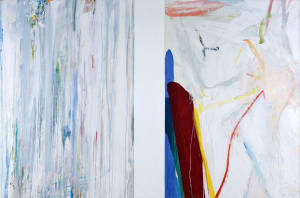Robert S. Neuman: Under the Spanish Sun
Friday, Sep 20, 2024 10:00a -
Sunday, Nov 17, 2024 6:00p
Where:
Childs Gallery
168 Newbury Street
Boston, MA 02116
Admission:
FREE
Categories:
Art
Event website:
childsgallery.com
American abstract artist Robert S. Neuman first visited Spain on a Guggenheim Fellowship in 1956. The experience was profound for Neuman, prompting major stylistic changes, as well as inspiring a second visit for his honeymoon in the late 1970s. Robert S. Neuman: Under the Spanish Sun presents the artist’s work from both sojourns and explores his distillation of Spanish culture onto canvas. Surveying these two distinctive yet innately related periods within the artist’s oeuvre, the exhibition affirms Neuman’s strong connection to Iberia – his fascination with Spain’s inherent mysticism and spirituality translating into abstracted planes of color, form, and light.
Neuman’s first trip to Spain found the artist centered in Barcelona, the northeastern capital of the autonomous community of Catalonia. There, Neuman was deeply moved by the particular atmosphere of the city, noting specifically that Barcelona’s light projected dazzling effects onto other colors, even seemingly dull neutrals:
“The light around Barcelona was very interesting. Any little thing seems to be very chromatic. I started painting with…these beautiful grays. I hadn’t painted with gray before because I thought it was a neutral color, but the atmosphere and the light were such that even grays seemed to contain a great deal of color.”
In the Barcelona paintings Neuman strove to capture this unusual effect of light, as well as the spiritual essence he felt implicitly tied to the country through its history of religious pluralism. Catholicism, Judaism, and Islam all thrived at different points in Spanish history though they were frequently violently at odds with one another. These paintings, such as Muro Catalano and (Untitled) Flag exhibit hues which deftly mimic the early dawn and dusk hours of northern Spain. The colors are pleasing, yet the paintings themselves hold within a buzzing energy reverberating from frenetic planes of black, which bisect the canvases. These strokes of inky darkness are perhaps Neuman’s allusions to the country’s turbulent history of zealotry, war, and persecution, or maybe a suggestion of the mysticism ingrained in such religious fervor, or both. They also reflect the influence of prominent Spanish artists such as Albert Ràfols-Casamada, Antoni Tàpies, and J.J. Tharrats, whose studios Neuman frequented at the time and notably used ‘violent colors and huge brush strokes’ in their paintings.
Neuman returned to Spain in the late 1970s, this time settling in Granada, the capital of Andalusia, for his honeymoon. Here, again, Neuman was taken with the perceived effects of light, this time observing its play within the intricate architecture of the Alhambra, a 13th century Moorish palace complex and home to the Nasrid dynasty before its fall to the Catholic monarchs Ferdinand II and Isabela I in 1492. Neuman was entranced by the palatine structure’s famous colonnades which through slender columns produced broken bands of light, creating a repeating pattern of views and interruptions on the Alhambra’s time-worn walls. From these rays of light, lines of seeing and not seeing, Neuman developed a specific reoccurring visual language for his Alhambra series – striations of color paired with columnar forms of white representing the palaces walls and pillars and the effects of sunlight on such architecture.
Many of the Alhambra paintings were produced after the artist’s return to the United States, with the elements of time and physical distance cultivating interesting effects in the resultant works. These later pieces, such as Alhambra Drawing, see Neuman venturing further into abstraction than previous iterations in the series. The columns begin to shift, tilting as if demonstrating the passage of sunlight through the day, and cut across riotous backgrounds of bursting strokes and splotches of color. Neuman would continue to work within the series for years after his return, using his paintings, drawings, and studies to further explore Spain’s rich atmosphere and history through an increasingly abstracted Alhambra vernacular.
In Spain Neuman found inspiration to examine, breakdown, and rethink the major elements of his paintings: color, light, and composition. Though not a religious man himself, the artist’s time in Barcelona and Granada was tantamount to an artistic spiritual experience, allowing Neuman to encapsulate the soul of a country through his abstracted vision of its distinctive culture and history.
Robert S. Neuman: Under the Spanish Sun is on view September 20 through November 17, 2024. An opening reception will be held Friday, September 20, 6-8pm
-

Sponsored -

SponsoredGood Morning Newbury Street, with coffee!
Saturday, Apr 26, 2025 9:00a
Outside the Newbury Hotel entrance
-

Sponsored -

Sponsored -

Sponsored -

Sponsored¡Conversaciones Crepusculares!: free in-person Spanish convo practice
Friday, May 02, 2025 4:00p
Boston Area Spanish Exchange (BASE)
-

SponsoredBoston Chocolate Tour - Beacon Hill to Boston Public Market
Saturday, Apr 26, 2025 11:00a
Meeting Spot
-

Sponsored -

Sponsored


